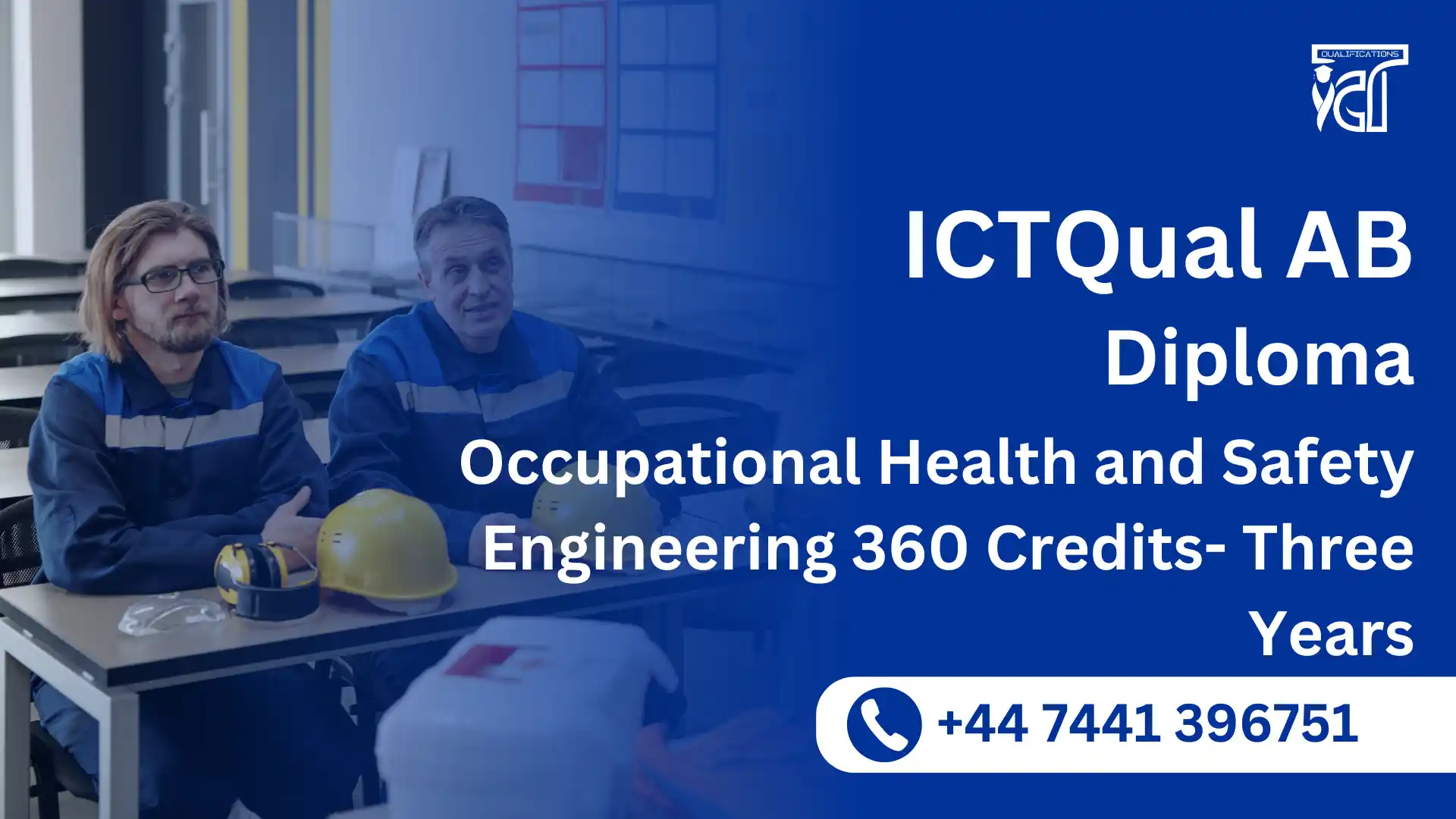The ICTQual AB Diploma in Occupational Health and Safety Engineering 360 Credits- Three Years is a comprehensive three-year programme designed for learners aspiring to excel in health, safety, and engineering sectors. With a robust 360-credit structure, this course equips both freshers and experienced professionals with the practical knowledge and technical expertise required to thrive in dynamic workplace environments.
Learners gain an in-depth understanding of occupational health and safety principles, risk assessment strategies, hazard management, and regulatory compliance. The programme emphasises industry-relevant skills, including safety engineering design, accident prevention techniques, and effective emergency response planning, enabling learners to make immediate and impactful contributions to their organisations.
Completing this diploma opens up a wealth of career opportunities, from health and safety officer roles to engineering safety consultancy positions, with potential pathways into management and specialised safety engineering fields. Learners develop critical thinking, problem-solving, and decision-making abilities that are highly sought after by employers across diverse industries, including construction, manufacturing, energy, and public services.
Key benefits of the programme include enhanced professional credibility, advanced technical skills, and a strong foundation for long-term career growth. By combining practical applications with theoretical knowledge, learners can confidently implement safety strategies, improve workplace compliance, and lead initiatives that safeguard employees and assets.
Ideal for individuals seeking both career progression and a solid professional edge, this diploma ensures learners are fully prepared to meet international occupational health and safety standards, making them valuable assets in any professional setting.
ICTQual AB Diploma in Occupational Health and Safety Engineering 360 Credits- Three Years
This qualification, the ICTQual AB Diploma in Occupational Health and Safety Engineering 360 Credits- Three Years, consists of 36 mandatory units.
Year 1 – Foundation Level
- Introduction to Occupational Health and Safety
- Principles of Risk Assessment and Management
- Workplace Safety Legislation and Compliance
- Fundamentals of Fire Safety Management
- Personal Protective Equipment (PPE) in the Workplace
- Environmental Health and Safety Awareness
- Accident Investigation and Reporting Procedures
- Ergonomics and Human Factors in Safety
- Health and Safety Communication Skills
- Hazard Identification and Control Measures
- Basics of Industrial Hygiene
- Introduction to Emergency Preparedness and Response
Year 2 – Intermediate Level
- Advanced Risk Assessment Techniques
- Fire Safety Systems and Evacuation Planning
- Safety Management Systems (ISO 45001)
- Workplace Safety Auditing and Inspection
- Electrical Safety in the Workplace
- Mechanical and Machinery Safety
- Environmental Protection and Sustainability Practices
- Occupational Health Monitoring and Surveillance
- Safety Leadership and Team Management
- Hazardous Materials and Chemical Safety
- Noise, Vibration, and Occupational Stress Management
- Construction and Industrial Safety Practices
Year 3 – Advanced Level
- Strategic Health and Safety Management
- Advanced Fire Risk Management and Prevention
- Safety Culture Development and Behavioural Safety
- Advanced Accident Investigation and Root Cause Analysis
- Ergonomic Risk Management in Industrial Settings
- Emergency Planning and Crisis Management
- Safety Performance Metrics and KPI Analysis
- Legal Compliance and Occupational Safety Standards
- Environmental Health and Safety Policy Development
- Health and Safety Project Planning and Implementation
- Leadership in Occupational Safety Engineering
- Capstone Project in Occupational Health and Safety Engineering
Below are the learning outcomes for each of the study units in the ICTQual AB Diploma in Occupational Health and Safety Engineering 360 Credits- Three Years:
Year 1 – Foundation Level
Introduction to Occupational Health and Safety
- Understand the fundamental principles of occupational health and safety engineering.
- Identify key hazards and risks in diverse workplace environments.
- Explain the role and responsibilities of a health and safety professional.
- Recognise the importance of a strong safety culture and ethical practice.
- Familiarise with international occupational health and safety standards.
- Appreciate the professional value of the ICTQual AB Diploma in Occupational Health and Safety Engineering.
Principles of Risk Assessment and Management
- Apply basic risk assessment methodologies to workplace hazards.
- Identify, evaluate, and prioritise occupational risks effectively.
- Develop simple and practical risk management plans.
- Implement control measures to reduce hazards to acceptable levels.
- Monitor and review risk assessments to support continuous improvement.
- Understand the relevance of risk assessment in the 360 Credits Occupational Safety Diploma.
Workplace Safety Legislation and Compliance
- Understand key occupational health and safety laws and regulations.
- Interpret legal responsibilities for learners and employers.
- Apply compliance procedures to meet statutory requirements.
- Maintain records in accordance with regulatory obligations.
- Recognise consequences of non-compliance in industrial and corporate settings.
- Enhance professional credibility through legal and regulatory awareness.
Fundamentals of Fire Safety Management
- Understand fire behaviour, hazards, and prevention strategies.
- Develop basic fire safety and emergency response plans.
- Identify and use appropriate fire-fighting equipment safely.
- Promote fire safety awareness among learners and colleagues.
- Conduct basic fire drills and preparedness exercises.
- Apply fire safety principles in line with Occupational Health and Safety Engineering standards.
Personal Protective Equipment (PPE) in the Workplace
- Identify different types of PPE and their correct usage.
- Evaluate PPE effectiveness for specific hazards.
- Ensure proper selection, maintenance, and storage of PPE.
- Promote correct PPE usage among learners and teams.
- Understand PPE legislation and compliance requirements.
- Integrate PPE practices into workplace safety management systems.
Environmental Health and Safety Awareness
- Recognise environmental hazards impacting workplace health and safety.
- Understand sustainability and environmental protection practices.
- Implement basic measures to minimise environmental risks.
- Support organisational initiatives for environmental health and safety.
- Raise awareness of occupational health issues related to environmental exposure.
- Promote sustainable practices in alignment with industrial safety standards.
Accident Investigation and Reporting Procedures
- Understand the importance of accident investigation in occupational safety.
- Apply systematic procedures for accident analysis.
- Analyse causes of incidents using investigative techniques.
- Prepare clear and accurate accident reports.
- Recommend corrective actions to prevent recurrence.
- Enhance organisational learning in occupational health and safety engineering.
Ergonomics and Human Factors in Safety
- Understand ergonomic principles and their impact on workplace safety.
- Identify human factors contributing to accidents and incidents.
- Apply ergonomic solutions to improve productivity and safety.
- Promote learner awareness of musculoskeletal and ergonomic risks.
- Integrate ergonomic considerations into workplace design.
- Support professional development in OHS engineering practices.
Health and Safety Communication Skills
- Develop effective communication strategies for workplace safety.
- Prepare safety briefings and instructional materials.
- Use clear and professional reporting for incidents and hazards.
- Promote a positive safety culture through communication.
- Facilitate learner engagement in health and safety programmes.
- Strengthen professional credibility in occupational health and safety.
Hazard Identification and Control Measures
- Identify common workplace hazards across industries.
- Apply control measures following the hierarchy of controls.
- Evaluate the effectiveness of hazard control strategies.
- Document hazards and implement corrective actions.
- Support continuous improvement in occupational safety practices.
- Contribute to safer workplace environments in line with OHS standards.
Basics of Industrial Hygiene
- Understand principles of industrial hygiene and occupational exposure.
- Identify physical, chemical, and biological hazards in workplaces.
- Apply basic monitoring techniques to assess exposure levels.
- Recommend preventive measures to reduce health risks.
- Promote learner awareness of hygiene and health standards.
- Integrate industrial hygiene practices into 360 Credits Occupational Safety Diploma training.
Introduction to Emergency Preparedness and Response
- Understand key elements of emergency planning.
- Identify potential emergency scenarios in industrial and corporate settings.
- Develop basic response and evacuation procedures.
- Participate in emergency drills and exercises effectively.
- Promote safety awareness and preparedness among learners.
- Apply emergency planning principles in occupational health and safety engineering.
Year 2 – Intermediate Level
Advanced Risk Assessment Techniques
- Apply advanced risk assessment methodologies in occupational health and safety engineering.
- Conduct quantitative and qualitative analyses of workplace hazards.
- Evaluate complex hazards in industrial and high-risk environments.
- Develop comprehensive risk management strategies for workplace safety.
- Monitor and review risk assessment outcomes to support continuous improvement.
- Strengthen professional skills in 360 Credits Occupational Safety Diploma practices.
Fire Safety Systems and Evacuation Planning
- Understand advanced fire detection systems and fire prevention technologies.
- Develop detailed fire evacuation plans and emergency procedures.
- Assess fire risk management strategies in complex workplaces.
- Implement fire drills and preparedness programmes for learners and staff.
- Evaluate fire safety compliance and recommend improvements.
- Promote effective fire safety management in line with OHS standards.
Safety Management Systems (ISO 45001)
- Understand the framework of ISO 45001 occupational health and safety management systems.
- Implement and maintain safety management systems in workplaces.
- Monitor performance against ISO 45001 standards to ensure compliance.
- Conduct internal audits and evaluate safety system effectiveness.
- Foster continuous improvement and integrate a strong safety culture.
- Apply strategic safety practices for industrial and occupational safety.
Workplace Safety Auditing and Inspection
- Conduct systematic workplace safety inspections and audits.
- Identify non-compliance and recommend corrective actions.
- Prepare professional audit reports with actionable outcomes.
- Use auditing techniques to evaluate safety management system effectiveness.
- Encourage learner participation in inspection and audit processes.
- Enhance organisational safety performance through structured evaluation.
Electrical Safety in the Workplace
- Identify electrical hazards and assess associated risks.
- Apply safe working practices for electrical systems and equipment.
- Use protective equipment and controls to prevent electrical accidents.
- Recognise compliance standards for electrical safety.
- Develop awareness of safe electrical handling among learners.
- Integrate electrical safety measures into occupational health and safety practices.
Mechanical and Machinery Safety
- Identify mechanical hazards and associated risks in industrial settings.
- Implement safety measures for machinery operation and maintenance.
- Evaluate the effectiveness of guards, safety devices, and procedures.
- Promote safe use of machinery among learners and colleagues.
- Ensure compliance with mechanical safety regulations.
- Apply mechanical safety practices in 360 Credits Occupational Safety Diploma training.
Environmental Protection and Sustainability Practices
- Understand environmental protection regulations and industry best practices.
- Implement sustainable and eco-friendly initiatives in workplaces.
- Identify environmental hazards affecting occupational health and safety.
- Develop strategies to reduce environmental risks in industrial operations.
- Promote learner awareness of sustainability in safety practices.
- Integrate environmental health considerations into occupational safety management systems.
Occupational Health Monitoring and Surveillance
- Conduct occupational health monitoring and surveillance programmes.
- Identify early signs of occupational illness and exposure risks.
- Apply surveillance techniques for workplace hazards and environmental factors.
- Maintain health records and reporting systems accurately.
- Recommend preventive measures to protect worker health.
- Enhance professional capability in industrial health and safety engineering.
Safety Leadership and Team Management
- Develop leadership skills for occupational health and safety initiatives.
- Promote a positive safety culture among teams and learners.
- Apply strategies for effective safety communication and engagement.
- Manage safety projects and team responsibilities efficiently.
- Foster collaboration, accountability, and professional development.
- Strengthen leadership expertise in Occupational Health and Safety Engineering Diploma contexts.
Hazardous Materials and Chemical Safety
- Identify hazardous substances and evaluate associated workplace risks.
- Apply safe handling, storage, and disposal procedures for chemicals.
- Understand chemical safety legislation and compliance requirements.
- Implement emergency response measures for chemical incidents.
- Promote learner awareness of hazardous materials risks.
- Integrate chemical safety practices into 360 Credits Occupational Safety Diploma training.
Noise, Vibration, and Occupational Stress Management
- Understand occupational exposure to noise, vibration, and stress.
- Conduct assessments and monitor workplace conditions effectively.
- Develop strategies to reduce harmful exposure to physical and psychological hazards.
- Promote learner awareness of stress management and well-being.
- Implement ergonomic and organisational measures for health and safety.
- Strengthen professional skills in occupational health and safety engineering practices.
Construction and Industrial Safety Practices
- Apply safety principles in construction and industrial environments.
- Identify hazards specific to construction sites and industrial operations.
- Implement risk controls and safety procedures effectively.
- Conduct inspections and audits for regulatory compliance.
- Promote a proactive safety culture among learners and teams.
- Integrate construction and industrial safety practices into OHS engineering programmes.
Year 3 – Advanced Level
Strategic Health and Safety Management
- Develop strategic plans for occupational health and safety engineering within organisations.
- Align health and safety objectives with overall organisational goals.
- Implement advanced risk management frameworks at a strategic level.
- Evaluate safety performance metrics and recommend improvements.
- Engage learners and teams in strategic safety decision-making.
- Strengthen leadership skills for effective management in 360 Credits Occupational Safety Diploma contexts.
Advanced Fire Risk Management and Prevention
- Conduct detailed fire risk assessments in complex industrial and corporate workplaces.
- Develop and implement advanced fire prevention and mitigation strategies.
- Analyse fire incident trends and recommend improvements.
- Lead fire safety training and awareness initiatives for learners and staff.
- Ensure robust compliance with occupational health and safety engineering standards.
- Integrate fire risk management strategies into comprehensive workplace safety plans.
Safety Culture Development and Behavioural Safety
- Understand the role of safety culture in accident prevention and organisational performance.
- Implement behavioural safety programmes to influence learner and employee conduct.
- Assess and measure safety culture effectiveness using metrics and surveys.
- Promote continuous improvement in organisational safety culture.
- Encourage proactive safety behaviour across teams and departments.
- Embed safety culture principles into industrial and occupational safety engineering practices.
Advanced Accident Investigation and Root Cause Analysis
- Apply advanced investigative techniques to determine root causes of incidents.
- Prepare detailed accident reports with actionable recommendations.
- Analyse complex incidents in industrial and corporate environments.
- Recommend preventive strategies to avoid recurrence of accidents.
- Facilitate organisational learning from incident investigations.
- Strengthen professional expertise in occupational health and safety engineering practices.
Ergonomic Risk Management in Industrial Settings
- Conduct advanced ergonomic assessments in diverse workplaces.
- Design solutions to mitigate musculoskeletal and human factor risks.
- Evaluate the impact of ergonomics on productivity and workplace safety.
- Develop and deliver ergonomic training programmes for learners and teams.
- Promote proactive ergonomic practices across organisations.
- Integrate ergonomic risk management into OHS engineering strategies.
Emergency Planning and Crisis Management
- Develop comprehensive emergency and crisis management plans for workplaces.
- Implement response strategies for industrial, environmental, and corporate crises.
- Coordinate emergency drills and training exercises effectively.
- Evaluate response effectiveness and recommend improvements.
- Promote learner and organisational readiness for emergencies.
- Embed crisis management principles into occupational health and safety engineering programmes.
Safety Performance Metrics and KPI Analysis
- Identify key performance indicators (KPIs) for occupational health and safety.
- Collect, analyse, and interpret safety performance data for informed decision-making.
- Evaluate the effectiveness of safety initiatives using data-driven metrics.
- Prepare reports to guide strategic safety planning and organisational improvement.
- Support continuous improvement in safety performance and compliance.
- Integrate KPI analysis into 360 Credits Occupational Safety Diploma professional practice.
Legal Compliance and Occupational Safety Standards
- Interpret international occupational health and safety regulations and standards.
- Apply legal and compliance frameworks to workplace operations.
- Evaluate organisational practices for regulatory adherence.
- Maintain compliance documentation and reporting systems.
- Promote awareness of legal responsibilities among learners and teams.
- Embed regulatory compliance into occupational health and safety engineering initiatives.
Environmental Health and Safety Policy Development
- Develop comprehensive environmental and safety policies for organisations.
- Align policies with legal, regulatory, and international best practice standards.
- Communicate safety policies effectively to learners and stakeholders.
- Implement monitoring and review mechanisms to evaluate policy effectiveness.
- Promote sustainable and safe workplace practices.
- Integrate environmental and health safety policies into industrial safety engineering programmes.
Health and Safety Project Planning and Implementation
- Plan, implement, and manage occupational health and safety projects.
- Apply project management techniques to ensure successful safety initiative outcomes.
- Monitor project performance and evaluate risks and resource requirements.
- Foster team engagement and collaboration throughout project implementation.
- Ensure alignment of safety projects with organisational objectives.
- Strengthen professional skills in 360 Credits Occupational Safety Diploma project management.
Leadership in Occupational Safety Engineering
- Develop advanced leadership skills for health and safety roles.
- Guide teams in implementing effective safety strategies and initiatives.
- Promote a proactive, accountable, and positive safety culture.
- Apply decision-making frameworks in complex occupational safety situations.
- Mentor learners and colleagues in professional development and safety practices.
- Enhance leadership competencies within occupational health and safety engineering.
Capstone Project in Occupational Health and Safety Engineering
- Conduct a comprehensive research or practical project in occupational health and safety engineering.
- Integrate knowledge and skills gained throughout the diploma programme.
- Analyse real-world occupational health and safety challenges and develop practical solutions.
- Implement safety improvement strategies in industrial or corporate settings.
- Present findings professionally, demonstrating analytical and leadership competencies.
- Showcase mastery of ICTQual AB Diploma in Occupational Health and Safety Engineering outcomes.
The ICTQual AB Diploma in Occupational Health and Safety Engineering offers learners a range of practical and career-enhancing benefits. Designed to equip both freshers and experienced professionals with industry-relevant skills, this three-year, 360-credit programme ensures learners gain in-depth knowledge, technical expertise, and a competitive edge in occupational health and safety engineering. By completing this diploma, learners are prepared to take on key roles in workplace safety, risk management, and regulatory compliance, while developing essential professional competencies that support long-term career growth.
1. Enhanced Professional Skills
- Master core occupational health and safety principles.
- Develop expertise in hazard identification and risk assessment.
- Gain proficiency in safety engineering techniques.
- Learn practical strategies for accident prevention and emergency response.
- Apply theoretical knowledge to real-world workplace safety scenarios.
2. Career Advancement Opportunities
- Access roles such as Safety Officer, Safety Engineer, and Health & Safety Consultant.
- Strengthen credentials for managerial positions in safety and engineering.
- Enhance employability across construction, manufacturing, and energy sectors.
- Open pathways to specialised consultancy and technical roles.
- Build a professional profile that stands out to employers worldwide.
3. Industry-Relevant Knowledge
- Understand international occupational health and safety regulations.
- Learn best practices in compliance and workplace safety management.
- Develop skills for designing and implementing effective safety systems.
- Stay updated with evolving health and safety standards.
- Integrate risk mitigation strategies into everyday engineering practices.
4. Professional Credibility
- Achieve recognition for completing a structured 360-credit programme.
- Build trust with employers and peers through demonstrated expertise.
- Gain confidence in leading safety initiatives and projects.
- Showcase advanced knowledge in occupational health and safety engineering.
- Strengthen your professional reputation in local and international markets.
5. Long-Term Career Growth
- Develop critical thinking and problem-solving abilities.
- Enhance leadership and decision-making skills in safety contexts.
- Prepare for continuous professional development opportunities.
- Position yourself for long-term roles in senior safety or engineering positions.
- Equip yourself for a sustainable and rewarding career in occupational health and safety.
The ICTQual AB Diploma in Occupational Health and Safety Engineering is designed for learners from diverse backgrounds who are motivated to advance their careers in occupational health, safety, and engineering. Whether freshers seeking foundational knowledge or professionals aiming to enhance their technical expertise, this programme provides the skills, credibility, and industry relevance needed to succeed in dynamic workplace environments. Learners who enrol benefit from a structured, practical, and internationally recognised curriculum that prepares them for a wide range of roles and long-term career growth.
1. Aspiring Health and Safety Professionals
- Individuals looking to start a career in occupational health and safety.
- Fresh graduates seeking practical and technical expertise in workplace safety.
- Learners aiming to understand risk assessment and hazard management.
- Those motivated to implement safety strategies in engineering environments.
- Individuals seeking internationally relevant health and safety skills.
2. Experienced Professionals
- Current employees in engineering, construction, or manufacturing sectors.
- Safety officers or supervisors aiming to advance into senior roles.
- Professionals wanting to update knowledge of modern safety regulations.
- Learners seeking to enhance credibility and professional qualifications.
- Individuals aiming to specialise in occupational safety engineering practices.
3. Career-Focused Learners
- Individuals motivated by career progression and long-term growth.
- Learners seeking recognised qualifications to improve employability.
- Those aiming to enter management or consultancy positions in safety.
- Learners focused on gaining practical, industry-relevant skills.
- Individuals looking to expand professional networks and opportunities.
4. Lifelong Learners
- Those interested in continuous professional development.
- Learners committed to keeping up with evolving safety standards.
- Individuals seeking self-paced, assignment-based learning opportunities.
- Professionals looking to integrate theoretical and practical knowledge.
- Learners aiming to develop critical thinking and problem-solving skills.
5. International and Global-Minded Learners
- Individuals aspiring to work in multinational organisations.
- Learners seeking qualifications recognised across borders.
- Those interested in applying safety engineering standards globally.
- Professionals wanting skills adaptable to diverse industries and environments.
- Learners aiming to enhance employability in international markets.
Completing the ICTQual AB Diploma in Occupational Health and Safety Engineering equips learners with the skills, knowledge, and credibility to advance confidently in their careers. This three-year, 360-credit programme not only prepares learners for immediate roles in health and safety but also opens pathways for long-term professional growth, higher responsibilities, and specialised opportunities in both national and international workplaces. Learners gain the foundation to progress into senior management positions, consultancy roles, or further advanced studies, ensuring a sustainable and rewarding career trajectory.
1. Senior Health and Safety Roles
- Progress to positions such as Senior Safety Officer or Safety Manager.
- Lead workplace safety teams and oversee compliance initiatives.
- Develop and implement advanced risk management strategies.
- Supervise health and safety operations across multiple projects.
- Gain authority in policy-making and strategic safety planning.
2. Specialised Safety Engineering Positions
- Transition into roles focused on engineering-specific safety solutions.
- Design and manage safety systems in construction, manufacturing, or energy sectors.
- Conduct technical safety audits and assessments.
- Implement innovative hazard prevention and mitigation techniques.
- Work on complex safety engineering projects with cross-functional teams.
3. Consultancy and Advisory Opportunities
- Provide expert advice on occupational health and safety practices.
- Support organisations in achieving regulatory compliance.
- Conduct safety training programmes and workshops.
- Assist companies with risk assessment and accident prevention strategies.
- Offer specialised consultancy in workplace safety engineering.
4. Further Education and Professional Development
- Pursue advanced certifications or diplomas in health, safety, and engineering.
- Access postgraduate opportunities in occupational safety and risk management.
- Develop expertise in emerging areas such as environmental health and safety.
- Engage in continuous professional development (CPD) programmes.
- Expand knowledge to stay ahead of evolving international safety standards.
5. International Career Pathways
- Apply skills and qualifications in multinational companies.
- Explore health and safety roles across global industries.
- Adapt expertise to diverse workplace environments worldwide.
- Increase employability in international construction, engineering, and industrial sectors.
- Position yourself as a globally recognised occupational health and safety professional.
As an approved centre of ICTQual AB, we provide learners with flexible certification pathways tailored to their experience and career stage. Learners must enrol with us to access the programme and benefit from our structured support and guidance throughout the course.
Route 1: Experienced Professionals
- Designed for learners with at least 6 years of verifiable work experience in occupational health, safety, or engineering.
- Learners can leverage their existing knowledge and practical experience to complete the diploma efficiently.
- Focuses on recognising prior learning and professional achievements.
- Offers guidance in applying real-world expertise to course assignments.
- Ideal for professionals seeking formal recognition of their skills and career advancement.
Route 2: Fresh Learners
- Tailored for learners new to the field or without extensive prior experience.
- Requires the completion of 36 structured assignments over the three-year programme.
- Provides a step-by-step learning pathway to build practical and theoretical expertise.
- Ensures learners develop industry-relevant skills from foundational to advanced levels.
- Perfect for fresh graduates or individuals aiming to start a career in occupational health and safety engineering.
Both certification routes are designed to ensure learners gain comprehensive knowledge, professional credibility, and career-ready skills. Enrol with us today to begin your journey towards an internationally recognised diploma in Occupational Health and Safety Engineering.
Entry Requirements
The ICTQual AB Diploma in Occupational Health and Safety Engineering is designed to be accessible to a wide range of learners while ensuring they have the foundational skills to succeed. Learners must meet the following entry requirements to enrol:
1. Minimum Age
- Learners must be 18 years or older at the time of enrolment.
- Ensures maturity to engage with professional-level content.
- Suitable for both school leavers and working professionals.
- Age requirement aligns with international educational standards.
- Supports learners’ readiness for long-term career development.
2. Educational Background
- Learners should have a high school diploma or equivalent.
- Preferably with basic knowledge of science or engineering principles.
- Freshers can enrol via the assignment-based route to gain foundational knowledge.
- Prior academic qualifications are recognised for experienced learners.
- Open to learners from diverse educational streams who are motivated to build a career in occupational health and safety.
3. Experience
- Experienced learners: Minimum of 6 years verifiable work experience in occupational health, safety, or engineering-related fields.
- Fresh learners: No prior experience required; must complete 36 assignments over the programme duration.
- Ensures practical and theoretical learning is aligned with learners’ career stage.
- Supports recognition of prior learning and professional expertise.
- Experience-based entry facilitates faster progression for seasoned professionals.
4. Language Proficiency
- Learners must have a good command of English (reading, writing, and comprehension).
- Supports assignment-based learning and understanding of technical content.
- English proficiency ensures learners can engage with international standards.
- Recommended for learners to achieve at least IELTS 5.5 or equivalent if English is not their first language.
- Enables effective communication in professional and academic contexts.
5. Additional Requirements
- Learners must have basic computer literacy for online research, assignments, and digital learning tools.
- Access to a reliable internet connection for submitting assignments and accessing study materials.
- Commitment to complete the three-year, 360-credit programme through structured assignments.
- Motivation for continuous learning and professional development.
- Ability to apply theoretical knowledge to practical workplace scenarios.
Register Now
Qualification Process
Qualification Process for the ICTQual AB Diploma in Occupational Health and Safety Engineering 360 Credits- Three Years
- Self-Assessment:
Begin by evaluating your eligibility to ensure you meet the qualification requirements, including work experience, knowledge, and language proficiency. - Registration:
Complete your registration by submitting the required documents, including a scanned copy of a valid ID, and paying the registration fee. - Induction:
An assessor will conduct an induction to confirm your eligibility for the course and explain the evidence requirements. If you do not meet the criteria, your registration will be cancelled, and the fee will be refunded. - Assignments & Evidence Submission:
Provide all assignments and the necessary evidence based on the assessment criteria outlined in the course. If you are unsure of the required evidence, consult with the assessor for guidance on the type and nature of evidence needed. - Feedback and Revision:
The assessor will review your submitted evidence and provide feedback. Evidence that meets the criteria will be marked as “Criteria Met,” while any gaps will be identified. You will be asked to revise and resubmit if needed. - Competence Evidence:
Submit final evidence demonstrating that all learning outcomes have been met. This evidence will be marked as “Criteria Met” by the assessor once it is satisfactory. - Internal Quality Assurance (IQA):
The Internal Quality Assurance Verifier (IQA) will review your evidence to ensure consistency, quality, and compliance with standards. - External Verification:
The IQA will submit your portfolio to ICTQUAL AB External Quality Assurance Verifiers (EQA) for final confirmation. The EQA may contact you directly to verify the authenticity of your evidence. - Certification:
Upon successful completion of all checks, ICTQUAL AB will issue your official certificate, confirming that you have attained the ICTQual AB Diploma in Occupational Health and Safety Engineering 360 Credits- Three Years.







